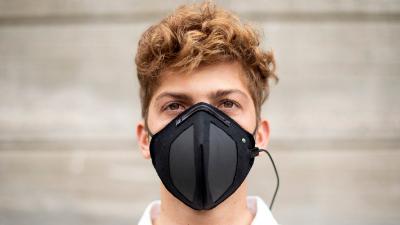As researchers and companies all over the world set out to battle the Coronavirus pandemic, many are revisiting graphene as a material with potential for helping to win this fight. The reasons for such potential could be found in graphene's known antibacterial/antiviral properties, its beneficial traits for medical sensors and devices and more.
Graphene has been shown in the past as extremely useful for creating various sensors. Earlier this month, a team led by Boston College researchers used a sheet of graphene to track the electronic signals inherent in biological structures, in order to develop a platform to selectively identify deadly strains of bacteria. In October 2019, Rice University team under chemist James Tour transformed their laser-induced graphene (LIG) into self-sterilizing filters that grab pathogens out of the air and kill them with small pulses of electricity. Commercially sold graphene-based sensors exist, like the graphene oxide (GO) sensor developed by the ICN2 Nanobioelectronics and Biosensors group that was added in 2016 to the list products offered by Biolin Scientific, a prestigious instrumentation company devoted to the production of analytical devices. The Q-Sense GO sensor enables interaction studies of GO with various analytes (measured substances) of interest and may open the door to various applications with interest for diagnostics, safety/security and environmental monitoring.
Graphene's properties can be harnessed to benefit the medical industry in various ways, and fighting Covid-19 could be among these. In June 2018, researchers at the University of Pennsylvania used graphene to increase the sensitivity of diagnostic devices, in particular those used to monitor and treat another famous virus - HIV. Graphene could be used to make better masks, gloves and gowns for medical teams. One such example is LIGC Applications' new Guardian G-Volt - face masks with a graphene filtration system that can be sterilized and safely re-used. With its graphene filtration system, the Guardian G-Volt is said to be 99% effective against particles over 0.3 micrometers, and 80% effective against anything smaller. A low level electrical charge will pass through Guardian G-Volt when it is plugged in to a portable battery pack via a USB port. This charge would repel any particles trapped in the graphene mask.

Chinese researchers from AECC Beijing Institute of Aeronautical Materials (AECC BIAM) have also reportedly developed a new type of face mask with graphene material on the key filter layer. The researchers have put a graphene-polypropylene material on the melt-blown fabric, which is the key filter layer of masks.
Graphene producers and application developers are joining the fight against Covid-19; Earlier this month, Italy-based Directa Plus said its graphene material could be used in medical devices to help authorities combat the Covid-19 pandemic. The company said its graphene was non-toxic and its bacteriostatic properties could be used in the production of medical devices to ensure better prevention properties for the spread of the virus. Another graphene company, Graphenea, Started offering free graphene to all those performing research on treatment and diagnosis of Covid-19, and also started producing a disinfectant alcohol-based hydrogel following World Health Organization recommendations and pharmaceutical guidelines. As part of its effort to join the battle against COVID-19, Graphenea will donate the hand sanitizer to public authorities for use in hospitals, by seniors, police and/or military personnel. The aim is to protect medical personnel, high risk groups, and law enforcement agents against the virus.
US-based Grolltex is working with Sanford Burnham Prebys Medical Discovery Institute to develop a graphene-based virus testing platform to help combat COVID-19. The project involves using hand held reader units and disposable plastic testing chips designed for U.S. points of entry including hospitals and point of care locations.
For more information on graphene, its properties and potential applications, check out our introduction to graphene article.

